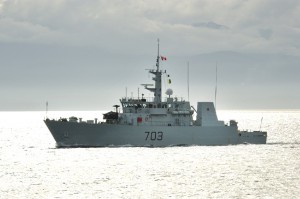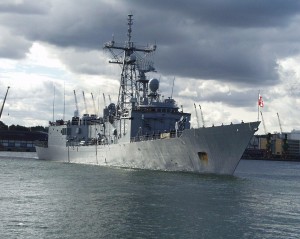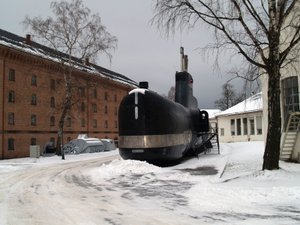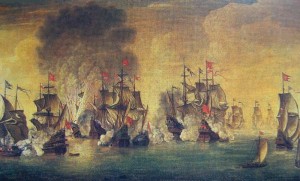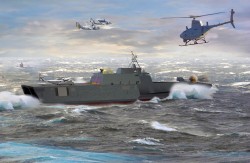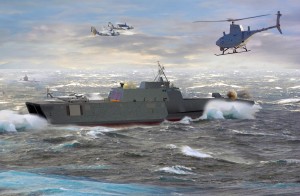
As of 31 October, the Russian Navy moved its headquarters back to the Admiralty building in St. Petersburg where it had been based until 1925. This is further, if superficial, evidence of President Vladimir Putin’s desire to revitalize and modernize the Russian fleet, and “maintain Russia’s place as a leading sea power.” Also on 31 October, the head of the Russian Navy, Admiral Viktor Chirkov, stated that he expects to add “up to five warships and auxiliary ships every year” through 2020. That is not a particularly impressive figure, but it is nothing to scoff at either. The number of ships added to the Russian Navy’s lists is only half the story. If President Putin hopes to strengthen Russian sea power relative to other maritime powers, then the Russian shipbuilding plan must be competitive with what others are doing. After accounting for the rate of decommissioning of Russian ships and the amount actually budgeted for Russia’s shipbuilding plan to 2020, as compared to U.S. plans, for example, it quickly becomes apparent those five ships a year are insufficient to achieve Putin’s desired revitalization of the fleet.
According to the state-owned news agency RIA Novosti, the Russian government set aside $156 billion for shipbuilding to 2020, or roughly $19.5 billion annually. This funding is expected to result in eight nuclear missile submarines, 14 frigates, 35 corvettes, six small artillery ships, and six landing ships – a total of 69 vessels. The average cost per unit under this plan is $2.26 billion, with only a handful of the hulls major combat assets. On the surface, the only major concern is the rather high cost for ships with limited capabilities. However, since Putin is concerned with improving the Russian Navy in both absolute terms and relative to its rivals – he wants Russia to be a great power again- it is a useful exercise to compare this shipbuilding plan with those of other leading sea powers.
A recent Congressional Budget Office (CBO) report on the U.S. Navy’s 2013 30-year shipbuilding plan notes some interesting differences. The U.S. Navy plans to add 268 ships by 2042, at a CBO projected cost of $599 billion.1 This is just shy of $20 billion per year, with a mean 8.9 ships commissioned annually.2 The cost per ship, however, comes in at $2.23 billion on average, cheaper than their Russian counterparts.3 On top of this, the planned U.S. ships are much more capable vessels. The plan includes 70 Arleigh Burke-class destroyers, 12 new ballistic missile submarines, 46 new attack submarines, 18 amphibious warfare ships, 46 logistics and support ships, and several aircraft carriers.4 Furthermore, these figures exclude the Littoral Combat Ship (LCS), roughly equivalent to a Russian corvette. When the two plans are held up against each other – admittedly an inexact comparison given the different time frames – the Russian Navy will continue to decline vis-à-vis its U.S. counterpart.
If the Russian Navy is to match President Putin’s ambitions, the rate of construction will not only have to be competitive with other naval powers, but will also have to be sufficient to compensate for the number of vessels decommissioned annually. In 2011, for example, two SSBNs and five landing ships left the fleet while one frigate and six landing craft entered service.5 A net neutral quantitative change, but arguably a net negative qualitative change. In 2010, one SSBN, a cruiser, two destroyers, two frigates, nine patrol craft, 13 mine countermeasures vessels, and seven landing craft entered or re-entered Russian service. This is compared with the loss of one SSBN, 28 patrol craft, an amphibious ship, a landing ship, and 11 landing craft.6 That is a net loss of seven vessels, but an arguable gain in capabilities. In 2009, the Russian Federation Navy added four attack submarines, one destroyer, and a landing ship but lost one SSBN, a destroyer, six frigates, and a landing craft.7 This is a net loss of three vessels, and a definite decline in capabilities. Now, admittedly this is not a perfect record of the comings and goings in the Russian Federation Navy as The Military Balance could be inaccurate. The Russian military is not known for its transparency, after all. The trend over the last three years appears, however, to be a decline in the size of the Russian Navy with, perhaps, some countervailing improvement in capabilities in certain areas. In 2011, seven ships were decommissioned, in 2010, 42 left service, and in 2009, nine were removed from the lists. Given the age of the majority of Russian vessels, it is unavoidable that a significant portion of the current Russian fleet will have to be decommissioned over the next five to ten years. Some of the oldest ships in the Russian fleet happen to be some of the most capable, meaning the loss will not be simply quantitative. The addition of five ships a year until the end of the decade certainly will help rejuvenate the aging Russian fleet, but it will not counteract its decline to the extent desired.
The Russian Navy appears dead in the water at this point. President Putin may wish for Russia to “maintain its status [as] one of the leading naval powers,” but the fact is that the Russian fleet is in decline and present plans are insufficient to absolutely or relatively increase its size and capabilities.8 Russia may or may not be America’s – or any other state’s9 – main geopolitical foe, but in the naval arena it is not much of a contest. Without even more money, the Russian Navy looks set to continue its decades’ long decline.
Ian Sundstrom is a graduate of the War Studies Masters Program at King’s College London. He is currently engaged on a research project for Imperial War Museum – Duxford in Cambridge, United Kingdom.
[1] Page 3.
[2] Page 7.
[3] Page 3.
[4] Pages 8-9.
[5] International Institute of Strategic Studies, The Military Balance 2012 and The Military Balance 2011
[6] International Institute of Strategic Studies, The Military Balance 2011 and The Military Balance 2010
[7] International Institute of Strategic Studies, The Military Balance 2010 and The Military Balance 2009
[8] The recent firing of Defense Minister Anatoly Serdyukov may signal a change in Putin’s designs for the military, but it is too soon to tell.
[9] Space considerations have prevented me from discussing other navies’ shipbuilding plans. The reader may wish to consider the trajectory of the British, Japanese, and Chinese navies and how they compare to the Russian fleet. My very brief, preliminary look suggests Russia is set to make some quantitative headway against Britain and Japan, but Russia’s position sandwiched between four major seas renders the gains less than impressive. Compared to the Chinese Navy Russia is in clear decline.



